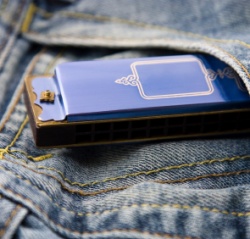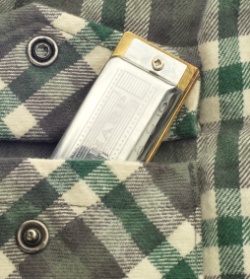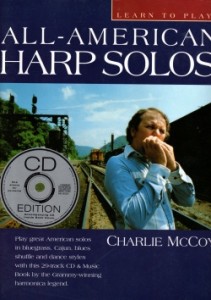Country Harmonica – First Steps
 I’m going up the country, baby do you wanna go?
I’m going up the country, baby do you wanna go?
So you’re a blues harp player and you’ve been asked to cover a country tune. Or perhaps the blues got you started on the harp, but now you want to try something different. Either way, where do you begin? You could try kicking off your shoes, rolling up your britches, wearing a big old cowpoke hat and wedging a tooth pick in your teeth. Not.
The answer is to start by mapping out the essential notes. We can look at technique and learn licks in future posts. But as a blues player, or any kind of player, the place to start is with the Country Scale. Let’s go..
 I’m going to some place where I’ve never been before
I’m going to some place where I’ve never been before
Although aspects of both styles are rooted in European folk music, Country Harp is the product of a different musical journey to the Blues. It draws less on the Black American narrative and more on the musical traditions fostered by early White settlers. Consequently, it is sometimes redolent of folk music from Ireland, the British Isles, Scandinavia and North West Europe.
Over time, the two disciplines have of course drawn from each other. Country and Piedmont Blues are recognised musical categories. There’s Zydeco, Western Swing and New Country – all of which share a strong blues infusion. You will find Cajun harp players and even Bluegrass embraces the humble diatonic lickin’ stick. Mike Stevens has been at it for years.
I’m going, I’m going where the water tastes like wine
Special country tunings do exist and some players alter standard reed tunings to make things more comfortable. For now though, we’re using a regular Richter tuned 10 hole diatonic harmonica. We’re going to assemble the ingredients that give Country Music it’s classic flavour. We’re in cross harp (second position) on an A harmonica – key of E major.
First work at the lower and upper octave scales independently. Play them up and down and build fluency. Then run them together and mess around with them. Find your own sequences. You’ll quickly identify the principal safe notes and those with a country character. The full bend 3D” to 3D, and reverse, will become pivotal in the lower octave.
Lower Octave Country Scale
2D 3D” 3D 4D 5B 6B
Upper Octave Country Scale
6B 6D 7D 8D 8B 9B
Looped Country Scale
For musical correctitude, here are the remaining safe notes that loop off the top end of the harp and onto the bottom end.
9B 10D 10B’ 1D 2B 2D
Now, using the mid octave, let’s start to throw things around a bit and see what comes out..
1D..2B 2D 2D 2D..2D
3D”..3D 4D..4D 3D..4D 5B
6B..5B 6B..5D 4D
3D..3D” 2D 2D
1D-2D-3D
 We can jump in the water, stay drunk all the time
We can jump in the water, stay drunk all the time
If you want the Good Doctor’s recommendation on a reliable reference book for Country Harping, then look no further than Charlie McCoy’s All-American Harp Solos (ISBN 0-7119-6680-x).
Word has it the book is currently out of print, but if you search long enough you can still find copies. Be forewarned, it includes a healthy dollop of schmaltz. But the good bits are very good.
Charlie paints from an eclectic palate; collectively his tunes provide a solid foundation of, and a great introduction to, country harp patterns.

I’m a blues player but just came back from watching the ‘Doo Wah Riders’ here in Monrovia, CA, and came back desperately searching for some kind of ‘bluffers guide’ Sir, you’ve done the business, got me a bluffin’ within 5 minutes. Thanks much!
Pete
Howdy Peter! Great that you found the first steps in Country Harp a useful introduction. If you want to take the next step, check out the Charlie McCoy stuff recommended. It’ll give you a really good grounding in the Country approach. And watch out for the secret ‘jaw swing’ technique for nailing faster sequences. Brendan Power adopted it for his Irish harping.
Thanks Wilf. Not sure if I went to a workshop of yours once, it would’ve been a Sunday, in Brighton, maybe 2pm-ish, went there after a L2B bike ride. Johnny Marrs was the main ‘clinician’ bout 2004 ish I think. Looking out for the Charlie McCoy stuff.
Yee haw from LA,
Peter
The best bluffers country harp is to draw in on 1-4 whilst saying “doh wah diddy, doh wah diddy, doh wah diddy” and blow a “doo” into 5. Then repeat the two “doh wah diddy”‘s but at the end instead of blow 5 do a 1 draw, 2 blow, 2 draw. Repeat this then you can continue with a run up 4d 5b 6b, 6d/6b 5b 4d – 5b 6b 5b 4d 4b 3d 3dbend 3d 3b. Opening and closing your cupping on the “doh wah diddy”s adds a nice touch. It works well. Try it and see. Yee hah.
Another thing … I’ve been asked to gig with a bluegrass banjo band. Not my things at all as I like sloooooooow blues. Anyone got any tips on how to increase my speed whilst chugging and doing the train stuff? My train falls off the tracks when going about 5mph. How do I get that super fast chugging sound? Any tips?
Hi James – some of it can be ‘doubled up’ with good articulation from the tongue and vocal tract. The power will always come from the underlying breathing pattern however, and consequently from the push-pull of your diaphragm. Try running up and down some stairs, then playing it…
Hi, I don’t understand why playing in second position, cross harp, for a country song is superior to simply playing the harp in the key of the song. Would greatly appreciate an explanation…Tony
Hi Tony. Depends on the song, but cross harp affords you much more in terms of phrasing and style.